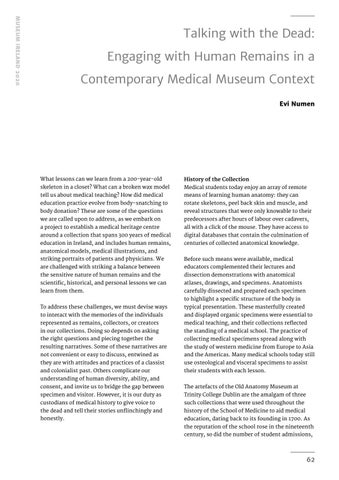MUSEUM IRELAND 2020
Talking with the Dead: Engaging with Human Remains in a Contemporary Medical Museum Context Evi Numen
What lessons can we learn from a 200-year-old
History of the Collection
skeleton in a closet? What can a broken wax model
Medical students today enjoy an array of remote
tell us about medical teaching? How did medical
means of learning human anatomy: they can
education practice evolve from body-snatching to
rotate skeletons, peel back skin and muscle, and
body donation? These are some of the questions
reveal structures that were only knowable to their
we are called upon to address, as we embark on
predecessors after hours of labour over cadavers,
a project to establish a medical heritage centre
all with a click of the mouse. They have access to
around a collection that spans 300 years of medical
digital databases that contain the culmination of
education in Ireland, and includes human remains,
centuries of collected anatomical knowledge.
anatomical models, medical illustrations, and striking portraits of patients and physicians. We
Before such means were available, medical
are challenged with striking a balance between
educators complemented their lectures and
the sensitive nature of human remains and the
dissection demonstrations with anatomical
scientific, historical, and personal lessons we can
atlases, drawings, and specimens. Anatomists
learn from them.
carefully dissected and prepared each specimen to highlight a specific structure of the body in
To address these challenges, we must devise ways
typical presentation. These masterfully created
to interact with the memories of the individuals
and displayed organic specimens were essential to
represented as remains, collectors, or creators
medical teaching, and their collections reflected
in our collections. Doing so depends on asking
the standing of a medical school. The practice of
the right questions and piecing together the
collecting medical specimens spread along with
resulting narratives. Some of these narratives are
the study of western medicine from Europe to Asia
not convenient or easy to discuss, entwined as
and the Americas. Many medical schools today still
they are with attitudes and practices of a classist
use osteological and visceral specimens to assist
and colonialist past. Others complicate our
their students with each lesson.
understanding of human diversity, ability, and consent, and invite us to bridge the gap between
The artefacts of the Old Anatomy Museum at
specimen and visitor. However, it is our duty as
Trinity College Dublin are the amalgam of three
custodians of medical history to give voice to
such collections that were used throughout the
the dead and tell their stories unflinchingly and
history of the School of Medicine to aid medical
honestly.
education, dating back to its founding in 1700. As the reputation of the school rose in the nineteenth century, so did the number of student admissions,
62















